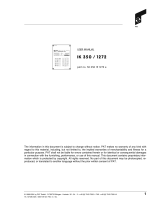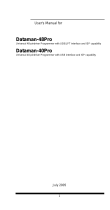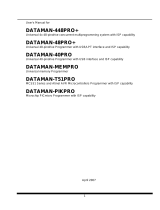Page is loading ...

1
TSM DS 50-003/REV.B/031-300-190-003/12-02-96
DS50 TROUBLE SHOOTING MANUAL LEVEL 3
Overload Warning
System DS 50
Trouble Shooting Manual
Level 3
- Calibration Adjustments -
Grove

2
TSM DS 50-003/REV.B/031-300-190-003/12-02-96
DS50 TROUBLE SHOOTING MANUAL LEVEL 3
NOTICE
The information in this document is subject to change without notice.
PAT makes no warranty of any kind with regard to this material, including,
but not limited to the implied warranties of merchantability and fitness for
a particular purpose.
PAT shall not be liable for errors contained in this manual or for incidental
or consequential damages in connection with the furnishing, performance,
or use of this manual. This document contains proprietary information
which is protected by copyright. All rights are reserved.
No part of this document may be photocopied, reproduced or translated
to another language without the prior written consent of PAT.

3
TSM DS 50-003/REV.B/031-300-190-003/12-02-96
DS50 TROUBLE SHOOTING MANUAL LEVEL 3
Item Content Page
1. Introduction to troubleshooting the PAT Overload Warning System DS50
1.1 System outline 5
1.2 System operation 7
1.3 Troubleshooting care 8
2.1 The hand terminal 10
2.2 The hand terminal connection 12
3.1 The start up menu 16
3.2 Displaying data and messages 17
3.3 The test program 19
3.4 The on-line mode 21
4Adjusting calibration data 23
5Identify the problem 24
6Adjusting overload cut off factor 25
7Adjusting empty hook load display 27
8Adjusting radius display under load 29
9Adjusting load display 31
10 Transferring EEPROM data 33
11 Error code messages 40
12 Removing test and calibration Equipment 48
Table of contents

4
TSM DS 50-003/REV.B/031-300-190-003/12-02-96
DS50 TROUBLE SHOOTING MANUAL LEVEL 3
CAUTION !
The use of the equipment and the procedures in the following sections allow data change of the
microprocessor system DS50 and its calibration.
Therefore only trained and authorized service personnel shall proceed with the procedures and
data adjustments described in this manual. Incidential errors in the calibration or software
change may result in a fatal accident. Always verify software change or calibration change
results.

5
TSM DS 50-003/REV.B/031-300-190-003/12-02-96
DS50 TROUBLE SHOOTING MANUAL LEVEL 3
NOTICE
THIS TROUBLE SCHOOTING MANUAL “DS 50 - LEVEL 3” IS DESIGNED TO ASSIST
THE SERVICE OR MAINTENANCE PERSONNEL IN ADJUSTING THE EXISTING
CALIBRATION DATA AND TRANSFERRING CALIBRATION DATA INTO A REPLACEMENT
DS 50 CENTRAL UNIT.
THIS TROUBLE SHOOTING MANUAL DOES NOT REPLACE ANY CALIBRATION
INSTRUCTION. THEREFORE IT SHOULD NOT BE USED AS A CALIBRATION
MANUAL.
IN ORDER TO PERFORM THE ADJUSTMENTS IN THIS TROUBLE
SHOOTING MANUAL YOU REQUIRE A SPECIAL TOOL SET. THE TOOL SET CONSISTS
OF THE PROFORT 803 HAND TERMINAL, THE DATAMAN S4 EPROM PROGRAMMER,
THE INTERFACE BOARD, A SET OF CABLES AND A PRE-PROGRAMMED E-PROM.
WE ASSUME THAT REGULAR MAINTENANCE AND SERVICE TOOLS AND A DIGITAL
VOLTMETER ARE AVAILABLE ON SITE.
THIS TROUBLE SHOOTING MANUAL DS 50 - LEVEL 3- IS THE CONTINUATION OF
TROUBLE SHOOTING MANUAL DS 50 - LEVEL 1- AND -LEVEL 2- AND ASSUMES
THE KNOWLEDGE OF THE CONTENT OF THE PREVIOUS LEVELS .
WE SUGGEST THAT ONLY TRAINED MAINTENANCE AND SERVICE PERSONNEL
PROCEED WITH THE TROUBLE SHOOTING DESCRIBED IN THIS MANUAL.

6
TSM DS 50-003/REV.B/031-300-190-003/12-02-96
DS50 TROUBLE SHOOTING MANUAL LEVEL 3
1. INTRODUCTION TO TROUBLESHOOTING THE PAT DS 50
1.1. SYSTEM OUTLINE
The PAT Overload Warning System Model DS 50 is designed to disable the boom
down and up, hoist up and tele out crane functions when the crane attempts to lift
over its limits. These limits are specified in the load capacity chart provided by the
crane manufacturer.
When the DS 50 system detects an overload condition the following crane
functions are disabled immediately.
a. telescope out
b. boom up and boom down
c. hoist up
To remove the overload condition the operator must achieve a safe working
condition. This can be achieved by lowering the load and repositioning the crane
or decreasing the radius by telescoping in. Observe that the radius can not be
decreased by lifting the boom. The boom up function is disabled while
attempting to overload the crane.
The system design allows you to operate the crane in an emergency situation or
system failure without the DS 50 system in operation . In this situation leave the
crane electric switch in the off position and press the override button while you
operate the crane manually. The DS 50 Overload Warning System is not operative
and can not warn the operator with the electric power switch in off position.
Warning
Bypassing the DS 50 Overload Warning system
may results in property damage, injury or death.
The DS 50 system contains a central unit with integrated length and angle sensor.
The load cell is supporting the hoist drum and used to measure the load on hook.

7
TSM DS 50-003/REV.B/031-300-190-003/12-02-96
DS50 TROUBLE SHOOTING MANUAL LEVEL 3
DRAWING 1.1 - SYSTEM LOCATION (FMTV-WRECKER)
DS 50 SYSTEM
LENGTH CABLE
BOOM
LOAD CELL
PROXIMITY
SWITCH
BOOM
LIFT CYLINDER
HOOK BLOCK
MAST
LENGTH CABLE MOUNT
LENGTH CABLE ENTRY
HOIST DRUM
CABLE CONNECTORS
LENGTH SENSOR - UNDER COVER-
Note: The drawing shows
the model FMTV-W.
The FMTV-C has only single
line capability.
1. INTRODUCTION TO TROUBLESHOOTING THE PAT DS 50

8
TSM DS 50-003/REV.B/031-300-190-003/12-02-96
DS50 TROUBLE SHOOTING MANUAL LEVEL 3
1.2 SYSTEM OPERATION
The Microprocessor Central Unit operates as the control center of the system.
The length cable is connected to the boom nose. During telescoping the length
cable spools off a drum which turns the length potentiometer using a gear
assembly. The length potentiometer is a variable resistor which varies linearly
with the boom length. An angle sensor is built into the central unit which senses
the boom angle. The load cell provides the signal to calculate the load on hook.
The proximity switch located on the hoist drum switches to a different calibration
factor during spooling off the hoist rope. This will allow a steady load calculation
and compensates for the difference in the lever arm. All together the signals get
processed in the central Microprocessor unit where actual and rated load are
compared. The system de-energizes a relay and disables the appropriate crane
functions when the actual load exceeds the rated load by more than 10%.
1. INTRODUCTION TO TROUBLESHOOTING THE PAT DS 50

9
TSM DS 50-003/REV.B/031-300-190-003/12-02-96
DS50 TROUBLE SHOOTING MANUAL LEVEL 3
1.3. Troubleshooting Care
•Keep in mind while troubleshooting high quality electronic
components to use caution and necessary care while testing and
measuring DS 50 components and circuits of the crane electric's.
• Tools and test equipment must be in good order and shall be inspected
on a regular basis.
• Follow all safety instructions according to crane manufacturer’s
handbooks and safety instructions. Obey recommended practice and
safety standards applying to the job site.
• Secure the working area prior to testing and servicing the system.
• Never remove the load cell without firm support holding the hoist drum.
• Never let the length cable snap back to the central unit. The length
sensor drum is under high tension.
Warning
DS 50 Overload Warning System service and repair work
shall be performed by trained and authorized personnel only.
1. INTRODUCTION TO TROUBLESHOOTING THE PAT DS 50

10
TSM DS 50-003/REV.B/031-300-190-003/12-02-96
DS50 TROUBLE SHOOTING MANUAL LEVEL 3
Crane power switch Crane electric
junction box
Outrigger extend
proximity switches-
FMTV-Cargo only.
Caution !
Crane is shown folded for transportation.
For lifting operations the mast has to be in full upright position
and the hook lifted out of the transportation storage.
Hookblock storage position
DRAWING 1.2 - Crane storage position
Note: The drawing shows
the model FMTV-W.
The FMTV-C has only single
line capability.
1. INTRODUCTION TO TROUBLESHOOTING THE PAT DS 50

11
TSM DS 50-003/REV.B/031-300-190-003/12-02-96
DS50 TROUBLE SHOOTING MANUAL LEVEL 3
The key board of the Profort 803 hand terminal is divided in three main areas.
Refer to drawing 2.1.1 and locate the keys which are described in the text below.
• Numerical key pad: Used to enter numerical data.
• Alphabetical key pad: Used to enter commands (letters).
• Function keys: Used to correct, delete or confirm an entry or display.
Some keys are assigned to special hand terminal functions.
• Internal battery check key: By pressing the key the red LED on the left top row lights up
to indicate that the internal battery is charged. If the LED
does not light up the internal battery is not charged or is
defective. The hand terminal shall not be used until the battery
is replaced.
• Memory recall key: With the green key on the top right of the key board the last
entry can be reviewed - but not changed.
• Control LEDs:The LEDs above the numerical key pad light up to confirm the
on-line status and various key function. In example the green
File LED lights up after the shift key was pressed.
• The display (LCD): Indicates data and messages.
The use of the hand terminal in connection with the DS 50 System is described in the
course of the following instructions.
Part of the hand terminal is a cable. The DB 9 connector at the end of the cable shall be
connected to the interface ribbon cable which is connected into the DS 50 main board.
Refer to section 2.2 and drawing 2.2.1 and 2.2.2 for hand terminal connection.
CAUTION: The DB 9 connector is wired especially for the DS 50 interface. Do not
attempt to connect the hand terminal to any device other than the DS 50.
2.1 THE HAND TERMINAL

12
TSM DS 50-003/REV.B/031-300-190-003/12-02-96
DS50 TROUBLE SHOOTING MANUAL LEVEL 3
2.1 THE HAND TERMINAL
Drawing 2.1.1

13
TSM DS 50-003/REV.B/031-300-190-003/12-02-96
DS50 TROUBLE SHOOTING MANUAL LEVEL 3
2.2 THE HAND TERMINAL CONNECTION
In order to connect and use the hand terminal for data read-out or data adjustment
the DS 50 hardware must be prepared as follows:
• Switch the truck power off and remove the DS 50 central unit cover carefully as
described in manual level 1&2.
• Carefully insert the interface board into the interface board socket on the main
board.
CAUTION: The hole location in the interface board must match the hole location
on the main board. Otherwise you may damage the interface and
main board when powering the system up. Do not break, bend or skip
any pins on the interface board while you plug the board into the socket.
Refer to drawing 2.2.1 for installation of the interface board.
• The ‘plug in’ jumper J2 next to the interface board socket must be closed (mid & top
position of the 3 pin connector). Refer to drawing 2.2.2. Note the hand terminal will
not function with J2 not in the correct position.
• Plug the small ribbon cable adapter with the 10 conductor female plug into the male
interface connector on the main board next to the interface board socket.
• Plug the female DB 9 connector of the hand terminal cable into the male DB 9
connector at the other end of the ribbon cable. Refer to drawing 2.2.3 for cable
connection.
• Secure the ribbon and hand terminal cable with cable ties to avoid cable stress or
pulling off connections while operating the crane.

14
TSM DS 50-003/REV.B/031-300-190-003/12-02-96
DS50 TROUBLE SHOOTING MANUAL LEVEL 3
Drawing 2.2.1
2.2 THE HAND TERMINAL CONNECTION

15
TSM DS 50-003/REV.B/031-300-190-003/12-02-96
DS50 TROUBLE SHOOTING MANUAL LEVEL 3
Drawing 2.2.2
2.2 THE HAND TERMINAL CONNECTION

16
TSM DS 50-003/REV.B/031-300-190-003/12-02-96
DS50 TROUBLE SHOOTING MANUAL LEVEL 3
Drawing 2.2.3
2.2 THE HAND TERMINAL CONNECTION

17
TSM DS 50-003/REV.B/031-300-190-003/12-02-96
DS50 TROUBLE SHOOTING MANUAL LEVEL 3
3.1 THE START UP MENU
Follow the instructions described in section 2.2 to connect the on-line equipment.
Switch the truck power on. A cursor appears on the top left of the hand terminal
display and the red ‘online’ LED lights up. After the DS 50 system has passed the
selftest routine, the display shows the start up menu. Refer to drawing 3.1.
The following letters allow the user to select the desired program.
• D = Data output to PC terminal mode. Not used for hand terminal operation.
• H = Data output to hand terminal Profort 803.
• O = Select the on-line mode. The on-line mode must be selected to adjust
calibration data.
• T = Select the test mode. The test mode allows the user to initialize the EEPROM
prior to a new calibration only and to test the digital inputs such as the function
of the hoist layer switch.
Caution: Do not initialize a calibrated system. Incidently initialization of the EEPROM
results in loss of calibration data and a recalibtaion becomes neccessary.
Refer to the appropriate section in this manual to distinguish what letter key of the
start up menu to select.
Drawing 3.1.1

18
TSM DS 50-003/REV.B/031-300-190-003/12-02-96
DS50 TROUBLE SHOOTING MANUAL LEVEL 3
3.2 DISPLAYING DATA AND MESSAGES
Follow the instructions in section 2.2 and 3.1
In order to identify the needfor a data adjustment, internally calculated data must be
compared with the actual measured data.
The DS 50 is an overload shut down system and is not classified as a scale. The
consideration of government specified tolerances is part of the trouble shooting
process. Crane and truck manufacturing tolerances do not allow calibrating an
overload shut down system with 0% tolerance.
To select the read out of geometrical data, load data and error messages press
the >H< key of the alphabetical key pad. The following information is now displayed.
Refer to drawing 3.2.1 to identify the displays described in the text below.
• Utilization of the lifting capacity in percentage. Overload cut off should be active
between 100% and 110%. The sample drawing 3.2.1 indicates an utilization of 84%.
• Maximum load capacity ( in lb/1000) for the actual boom position. The sample
drawing 3.2.1 indicates a maximum load capacity of 5,000 lb.
• Actual load on hook (in lb/1000). Note that the hook is not part of the load. The
sample drawing 3.2.1 indicates an actual load of 4,200 lb.
• Main boom length (in ft). The distance between the center of the boom pivot pin and
and the center of the sheave wheel pin.The sample drawing 3.2.1 indicates a
main boom length of 14.2 ft.
Refer to table below for fully retracted and fully extended boom length indication.
Indicated length
Crane model: retracted extended
FMTV Cargo 7.3 15.7
FMTV Wrecker 7.3 18.4
• Main boom angle (in degree) in reference to the horizontal line. The sample drawing
3.2.1 indicates a boom angle of 65.5 degree.
• Radius (in ft.). Radius is defined as the distance between center line of crane rotation
and the center line of the load freely suspended. The sample drawing 3.2.1 indicates
a radius of 15.7 ft.
• In the event of a malfunction, an overload condition, or an out of loadchart condition,
the radius display becomes replaced by the Error message. Refer to the error code
list to decode the message.

19
TSM DS 50-003/REV.B/031-300-190-003/12-02-96
DS50 TROUBLE SHOOTING MANUAL LEVEL 3
3.2 DISPLAYING DATA AND MESSAGES
Drawing 3.2.1

20
TSM DS 50-003/REV.B/031-300-190-003/12-02-96
DS50 TROUBLE SHOOTING MANUAL LEVEL 3
3.3 THE TEST PROGRAM
The test program is designed to initialize the E-EPROM prior to a new calibration and to
test the function of the digital inputs such as the hoist layer switch function.
Press the key >T< to start the test program. Refer to drawing 3.3.1 and 3.3.2.
The program allows to select the test routine:
•Press 4 to initialize the E-EPROM
CAUTION: DO NOT INITIALIZE A CALIBRATED SYSTEM. YOU WILL LOOSE ALL
CALIBRATION DATA IF YOU PRESS THE >Y< KEY AFTER THE MESSAGE
“OVERWRITE ? (Y/N)”. ALWAYS CONFIRM WITH THE >N< KEY IF YOU
ENTERED THE ROUTINE BY MISTAKE. WHEN TRANSFERRING DATA
TO A REPLACEMENT SYSTEM IT MAY BECOME NECESSARY TO
INITIALIZE THE REPLACEMENT SYSTEM BEFORE DATA
TRANSMISSION.
•Press 8 to test digital inputs
The hand terminal display indicates the actual status of three digital inputs.
DI 1 DI 2 DI 3
1 0 0
A >1< means the digital input is powered on and a >0< means the digital input is not
powered on.
In the example above the DI 1 is powered by the hoist layer switch. Switch off the hoist
layer switch by lowering the hoist and you can see the >1< changing to >0<.. For correct
adjustment of the switch refer to documentation in level 1 &2.
Note: No other digital input is used for the DS 50 FMTV application.
To return to the main menu press the >ESC< key or the letter key for the program you
wish to select.
/







